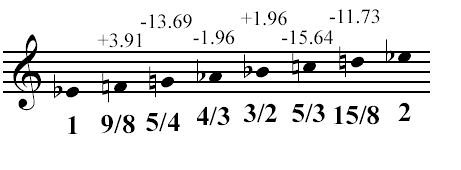Let's begin with the following hymn tune as a simple melodic basis:

Example 1: Hymn Melody
This melodic line has the following qualities:
- Diatonic, tonal melody in E Flat Major (Ionian mode)
- 8-bars in length (4/4 meter) with a pick-up of one quarter
- Rhythmically dominated by the long, short, short pattern of half-note followed by two quarters, emphasizing beats 1 & 3 (with all rhythmic momentum driving toward the first beat)
- Rhythmically dominated by quarters and half notes - the dotted quarter followed by an eighth note in measure 4 is the only exception and is largely heard as an ornamentation on the half note duration
One of the simplest operations to perform on any melodic line is straight transposition. For example, by raising each pitch in this melodic sequence by an augmented fourth we can transpose our melody into A Major.
Example 2. Hymn melody transposed.
With the exception of being in A Major, this melodic sequence retains all other harmonic and rhythmic qualities found in the original example.Transposition is a conceptually simple operation to perform and compositionally adds a small degree of variation (and some "dramatic" effect) without perceptually obliterating the source melodic sequence. It is an effective manipulation. Aesthetically, it's not terribly exciting.
5-Limit Just Intonation
Simple diatonic melodies such as this hymn excerpt are well-suited for 5-limit just intonation. The emphasis and scalar gravity of the tonic, major 3rd and perfect fifth of the root major triad are strongly suggestive of the 4th, 5th and 6th partials found in the overtone series and these are well represented by 5-limit just intonation. A typical 5-limit E flat Major (Ionian) Scale would be tuned as follows:

Example 3. 5-limit just intonation E Flat Major Scale
The numerical expressions on the bottom are the frequency ratio. This is said to be 5-limit just intonation because the largest prime factor in either the numerator or denominator of these ratios is 5. The +/- expressions on the top are the deviation, in cents, from equal tempered tuning. Each equal tempered semitone is 100.00 cents wide. The 9/8 major second is 3.91 cents larger than a 200.00 cent major second (for a total size of 203.91 cents). The 5/4 major third is 13.69 cents smaller than a 400.00 cent major third (for a total size of 386.31 cents). One of the qualities of a 5-limit just intonation scale such as this is that the root position major triad will have very little roughness as the overtones of each chord member will overlap exactly leading to an astonishing fusion of chord into timbre. You don't get that with equal tempered triads.
Applied to our original melody, you get the following:

Example 4. Hymn Melody in 5-limit Just Intonation.
This is only one possible way to tune this melodic sequence. But for a simple hymn melody, this is the intonation that most closely matches how one would naturally sing these intervals.
In future postings I will return to this melody and examine alternate methods for tuning and transforming this particular melodic sequence. I will also look at non-diatonic melodies and the kinds of intonation schemes that could be applied to them. Also, I'd like to examine my personal theory of texture classes in an effort to articulate a larger conceptual approach to music.
Applied to our original melody, you get the following:

Example 4. Hymn Melody in 5-limit Just Intonation.
This is only one possible way to tune this melodic sequence. But for a simple hymn melody, this is the intonation that most closely matches how one would naturally sing these intervals.
In future postings I will return to this melody and examine alternate methods for tuning and transforming this particular melodic sequence. I will also look at non-diatonic melodies and the kinds of intonation schemes that could be applied to them. Also, I'd like to examine my personal theory of texture classes in an effort to articulate a larger conceptual approach to music.



No comments:
Post a Comment